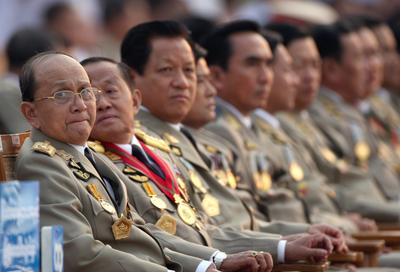Independent parties were never given a genuine chance to contest for power, and most of the key figures are retired military officers (and some active). This includes not only Thein Sein but also Vice President Tin Aung Myint Oo and a majority of the new cabinet line-up.
Yet the future regime is different from the old in important ways. To start, the previously cohesive military hierarchy is now divided into two distinct structures, one of which is subject to the vagaries of electoral competition, however restricted. Importantly, the new ‘civilian’ leaders are senior to the next generation of commanders and likely to be seeking to shift power to the civilian structures, which they control. At the very least, this will create some internal regime pluralism, not to mention tensions.
The appointment of Thein Sein — nominally by the new parliament but in reality by Senior General Than Shwe — came as a surprise to many observers who had been debating whether Than Shwe would keep it for himself or give it to his right-hand man, former chief of staff of the armed forces, Thura Shwe Man. In hindsight, however, Thein Sein was the obvious choice.
The ongoing political transition is part and parcel of Than Shwe’s personal retirement plan, and he was never likely to take on the presidency himself. It suits him much better to get the succession in place and exercise power, as needed, from behind the scenes through his trusted subordinates. Among the potential successors, Thein Sein was the safer choice for the Senior General since he has no apparent ambitions of his own. He is also tried and tested as head of government, well-respected within the military and relatively acceptable internationally.
Being more of a manager than a politician (or war-fighter), Thein Sein is unlikely to challenge existing power structures. Yet he is generally considered to be a decent man, and relatively clean. Along with the inclusion of several technocrats in the new cabinet, this could see some improvements in governance. The new president is also relatively approachable for foreigners, as is the new foreign minister, which should facilitate dialogue with the international community.
Much remains uncertain though. The new hierarchy is precariously balanced between softliners and hardliners, both in the government and the military, held in check by the continued de facto power of Than Shwe. Indications so far are that the Senior General favours some limited political and economic liberalisation to substantiate his claim to be transitioning to a more open system (and to secure his own position). But that assumes a conducive, non-threatening political environment, which could quickly deteriorate.
While Daw Aung San Suu Kyi, the recently released leader of the opposition National League for Democracy, which boycotted the November 2010 elections, has seemed conciliatory so far, her agenda of regime change sets her on a collision course with the new government that seems destined to end in violence. And in the country’s ethnic areas long-standing ceasefire agreements have collapsed, heightening the risk of a resumption of significant fighting.
In the international community, Burma’s neighbours have embraced the new system, and many Western governments, too, seem prepared to at least test whether it is different. The UK, however, has become the ‘new US’ and is pushing for all members of the new government to be immediately added to the sanctions list, a meaningless political gesture which can only alienate potential reformers and close openings for reengagement with the world.
One thing is sure: the basic structure of power in Burma remains unchanged, as does the underlying political culture shaped by more than half a century of armed conflict and military rule; and unless a process of reform takes hold early under the new regime any window for change is likely to close. This is what happened with the two previous regimes in 1962 and 1988, which both started with an agenda of change but soon turned defensive and reactionary. For those working for change, it is imperative, therefore, to encourage potential reformers while the opportunity is there.
To do so, they will have to take a leap of faith and dare to believe that the new government does have a reform agenda, and engage accordingly. The time for (further) disappointment and confrontation may come soon enough, but at this point, hope lives and should be nourished.
Dr Morten B. Pedersen is Senior Lecturer in Politics at the University of New South Wales at the Australian Defence Force Academy and a former Senior Analyst for the International Crisis Group in Burma.

